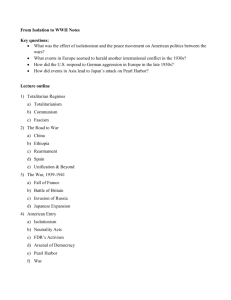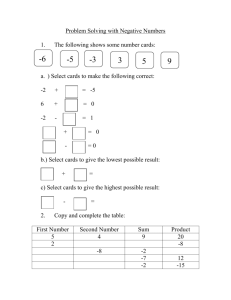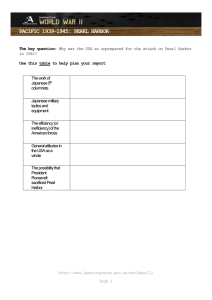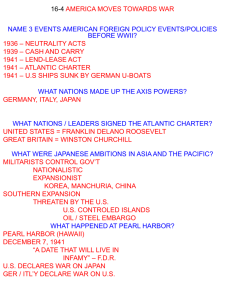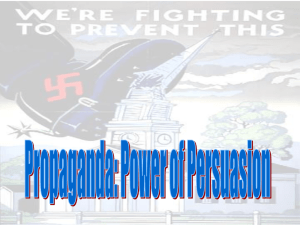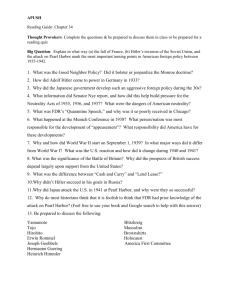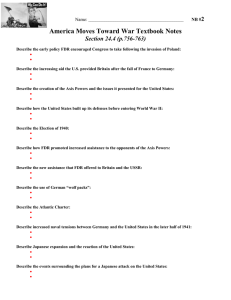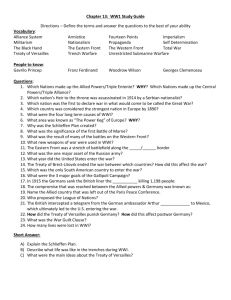U.S. in World Wars and Cold War
advertisement
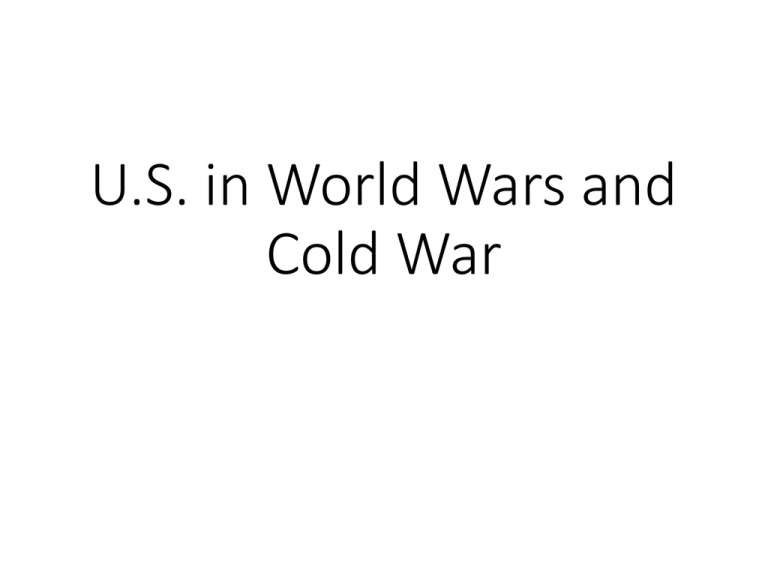
U.S. in World Wars and Cold War World Wars I and II • Unusual cases in military history • “Total war” approach – very modern concept • New technologies rapidly changing warfare • Even during the wars themselves • Global scale • World War II a bizarre example, not a typical example of warfare “Total War” • Nation vs. Nation • Enemy: “Britain,” “Germany,” “Russia” • Civilian/military distinction blurred • Even race vs. race: “the Japanese” • All society subject to mobilization • Mobilizes: material resources, organizations, culture, emotions, bodies • New strategies • Total blockade – Britain, WWI • Submarine blockade – Germany, WWI • Strategic bombing – various, WWII World War I (1914-18) • European conflict Central Powers – Germany, Austria-Hungary, Turkey Allied Powers – Britain, France, Russia, (Japan) • U.S. neutral but leaning to Allied side • U.S. joins Allied side in 1917 Becomes “Associated” Powers because the U.S. not fully an ally • Global aspects • European empires went to war • Japan joined Allied side to get German colonies in Asia/Pacific Allied vs. Central Powers World War I (1914-18) Woodrow Wilson and “Wilsonianism” • Foreign policy must be guided by ideals • Civilized conduct, collaboration, rights of countries • War should be just about territory and wealth • WWI a war to safeguard democracy • World needs a new international structure • • • • • To limit the possibility of war To act as a forum to air grievances Permanent body, not just occasional conferences For international cooperation on common issues U.S. must have an active role in these organizations • Context: WWI deadliest international conflict EVER (Before WWII broke the record) World War I (1914-18) Wilson’s “14 Points” • Blueprint for ending WWI • Designed to prevent similar wars in the future • To be basis for ending the war – a deal that all can agree on • Germany ultimately surrendered on basis of 14 Points • Ideals • Open diplomacy, free trade, self-determination, disarmament • Specific territorial transfers • Most of the points are about who gets what land • “League of Nations” “Isolationism” American disillusionment with World War I experience • By 1919, most Americans thought entering WWI had been a mistake • 1918-20 a depressing, frightening time for many Americans • Ironic results U.S. helps win the war, but does not ratify the peace treaty U.S. President created an international org. that the U.S. never joined U.S. President more popular in Europe than at home John T. McCutcheon “Interrupting the Ceremony” 1918 “Isolationism” “Isolation” mostly applied to European diplomacy U.S. increased its involvement in Latin America in the 1920’s American business, culture, and NGO’s expanded their international presence “Lesson of History” – 1920’s Insulate the U.S. even more from European affairs Don’t let internationalists (like Wilson) draw the country into a European war Applications, 1930’s: Neutrality Acts No loans to belligerents No arms sales to belligerents “Cash and carry” policy for everything else “Lesson of History” – 1920’s “Militarism” is the greatest danger in the world Applications, 1920’s: Washington Naval Conference, 1921-2 Limit naval arms races U.S. unilaterally scraps some of its ships Kellogg-Briand Pact, 1928 The most powerful nations renounced war as a tool of foreign policy World War II • Asia: 1931-45 • Europe: 1939-45 • U.S. neutral but leaning toward Allied side August, 1941 – Atlantic Charter U.S. and Britain agree to “bring an end to Nazi tyranny” • Japanese naval attack at Pearl Harbor (Dec. 7, 1941) accelerated U.S. entry into the war World War II • Very unusual war in military and diplomatic history • New approach • U.S. as “arsenal of democracy” + major military power • Allied goal: unconditional surrender of Axis powers • Prevent future world wars by occupying and redesigning the defeated countries • Create stronger international organization (United Nations) to maintain peace Pearl Harbor attack December 7 (local date), 1941 (December 8 in Japan, across the date line) Japanese strategic logic Calculated, rational, strategic decision Not anti-American hatred or “pure treachery” or “because they hated freedom” 1. War in China is the primary front 2. Japan needs oil, U.S. has cut off its oil sales to J. 3. Dutch East Indies has oil, so invade it 4. Invading D.E. Indies will lead to war w/ U.S. 5. If war inevitable, then start it in best way for J. 6. So, preemptive strike on Pearl Harbor (and Philippines) Pearl Harbor attack December 7, 1941 Pearl Harbor a secondary objective for Japan at the time Meanwhile, naval/land/air assaults on: • Philippines, Malaya, Singapore, Indonesia Mutual underestimation, mutual racism The Pacific, Dec., 1941 World War II – effects • 30-50 million dead, most in Soviet Union and China • Tens of millions displaced • Victorious countries (except U.S.) in ruins • 2 superpowers left standing – US, USSR • U.S. w/ largest navy and air force, 2nd largest army, atomic weapons • Brought into direct contact – Germany, Korea • Continued “bipolar” world • Both applied clear but incompatible “Lessons of History” to the postwar world • Cold War with roots in WWII World War II – effects • Weakened European empires • Decolonization movements, 1945-70’s • Colonies and former colonies – location of most of the wars since 1945 • New global organizations – United Nations • Human rights, international law structures • Prosecutions for “genocide,” “war crimes,” “crimes against humanity” “Lessons of History” – 1945 • Isolationism was a big mistake • U.S. security depends on being more involved in the world, not less • U.S. needs global presence, not just hemispheric one • Stand up to aggression immediately, no matter where it appears Cold War applications, 1946-91: Communists = Stalin = Hitler = totalitarian aggressors Korea, Viet Nam The Cold War • 1946-1991 • Tension between U.S. and Soviet Union (USSR) • “Cold” part • US and Sov. U. treated each other as enemies • Prepared for war w/ each other at any moment • But, did not go to war directly w/ each other • “Hot” reality • U.S. and Soviets w/ “proxy” wars around the world • Korea, Viet Nam, Afghanistan • Small-scale operations, assassinations, etc. Global commitment – Cold War • Truman doctrine, 1947 U.S. commitment to stopping totalitarian regimes anywhere and everywhere Bipolar world view -- “Free world” versus the “other” world • North Atlantic Treaty Organization (NATO), 1949 • Permanent peacetime alliance with Canada, Western Europe, Iceland, and Turkey (What would George Washington say?) • U.S. immediately involved in any future European war • “Pactomania,” 1949-55 By 1955, U.S. in permanent peacetime alliances in: W. Europe, Latin America, the Middle East, East Asia, Southeast Asia, and Australia/New Zealand
